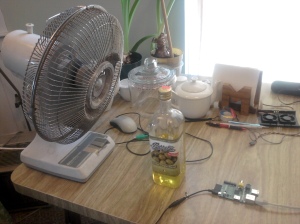The Raspberry Pi: My First Hardware Experiment
My shiny tiny new Raspberry Pi arrived last month, bringing with it a lot of hoopla and renewed enthusiasm for computing. Now that my first task of getting Slackware ARM installed to it, and configuring it to run “headless” (network only, no video or keyboard connected), it’s time to turn my attention to some hardware hacking. I decided to try out some basic cooling systems for it, to see if they make any appreciable difference in the RPi performance.
Not being able to afford a lab bench, or even access to a laboratory, I opted for a basic setup on my kitchen table. My first experiment focused on a forced-air cooling system (all images are clickable):
This cooling system made no measurable difference in the temperature of the device under test, even under full load. This is not surprising, since the RPi is very easy on the power requirements. Performance likewise remained unaffected.
Next, I tried water-cooling:
The results were rather disappointing. The investment in equipment provided no return for system cooling. I’m glad I didn’t go out and buy some water-purification equipment to go with it; I doubt it would have helped.
Next, I tried an oil-cooled system. Since the CO2 footprint of running the Raspberry Pi is so small, I opted for a plant-based oil instead of the usual mineral oil:
Again, no difference. I was really beginning to wonder if my experiment was going wrong, or if I really didn’t know what I was doing.
I remembered reading about some guys who wanted to overclock their system, so they stuck the motherboard in the freezer with bottles of vodka, while they progressively adjusted the jumpers and checked the frame rates in Doom. Well, the strongest thing I drink is beer, and I don’t want my RPi to draw condensation, so I opted for a slightly modified version of their hack:
I don’t know if it cooled the RPi any, or made the performance better. Before I did the test, I took another bottle out and drank it, so if I did run the test, I don’t remember where I put the file with the results. But I know it made me run a lot cooler!
In conclusion, the Raspberry Pi’s own cooling system is sufficient for just about any purpose. Kudos to Raspberry Pi designer Eben Upton for such a *ahem* cool design!





Hmmm, not sure if meant to me sarcastic or serious. Water cooling picture not exactly on par with this: http://www.techimo.com/forum/attachments/processors-memory-overclocking/11807d1094038238-cpu-fanless-water-cooling-system-reserator1-cpu-cooler.jpg
Not sure if your comment is sarcastic or serious. The post is marked “humo[u]r”.
Ohh. Didn’t see. I don’t normally visit this blog.
No prob. Just the human condition at work.
Haha brilliant :-D
Just you wait 4 those alu cases & we talk again ;)
Oh dear, I know your joking, but I’m really not surprised… Good job though, keep up the ‘hard’ work!!!
I hesitate to speculate on what you’d come up with if somebody suggested a heat sink.
You mean like you just did?
you made ma day dude, happy trolling lol.
Hello Guys,
I must comment on the statement of RPi’s being of low power consumption.
Maybe so – But – The heat dissipation was terrible.
On a recent project the RPi 3B+ would overheat and have all sorts of issues.
Being SLOW
Dropping Data and of course simply STOPPING
I did not have the small HEATSINKS on the two ICs so I put a metal ballpoint pen on top of the IC. NO mechanical bonding, just placed it on top. It worked for a while but the dissipation was not enough to keep the RPi working.
I then put a very small computer fan blowing on the metal ballpoint pen… That WORKED! It assisted in heat dissipation enough to let the RPi work.